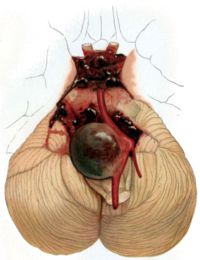
Photo from wikipedia
This study describes an attempt to develop a user-friendly nomogram incorporating psychological factors to individually predict the risk of radial artery spasm. Patients consecutively recruited between June 2020 and June… Click to show full abstract
This study describes an attempt to develop a user-friendly nomogram incorporating psychological factors to individually predict the risk of radial artery spasm. Patients consecutively recruited between June 2020 and June 2021 constituted the development cohort for retrospective analysis of the development of a prediction model. Least absolute shrinkage and selection operator regression combined with clinical significance was employed to screen out appropriate independent variables. The model’s discrimination and calibration were subsequently evaluated and calibrated by using the C-index, receiver operating characteristic (ROC) curve, and calibration plot. Decision curve analysis was also performed to evaluate the net benefit with the nomogram, and internal validation was assessed using bootstrapping validation. The predictors included in the risk nomogram included “body mass index ,” “anxiety score,” “duration of interventional surgery,” “latency time (time spent waiting in the catheterization laboratory),” “vascular circuity (substantial changes in the curvature of vessels),” and “puncture number.” The derived model showed good discrimination with an area under the ROC curve of .77, a C-index of .771 (95% CI: .72–.822) and good calibration. Decision curve analysis indicated that the nomogram provided a better net benefit than the alternatives.
Journal Title: Angiology
Year Published: 2022
Link to full text (if available)
Share on Social Media: Sign Up to like & get
recommendations!